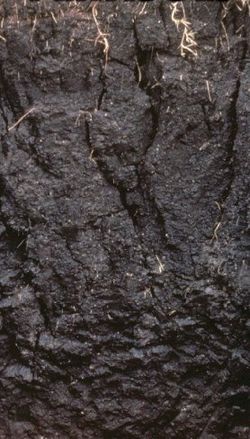Vertisols
| Vertisol | |
|---|---|

a Vertisol profile
|
|
| Used in | WRB, USDA soil taxonomy |
| WRB code | VR |
| Profile | OAC |
| Key process | clay pedoturbation |
| Climate | tropical savanna, semi-arid, humid subtropical, Mediterranean |
In both the FAO and USDA soil taxonomy, a vertisol (Vertosol in the Australian Soil Classification) is a soil in which there is a high content of expansive clay known as montmorillonite that forms deep cracks in drier seasons or years. Alternate shrinking and swelling causes self-mulching, where the soil material consistently mixes itself, causing vertisols to have an extremely deep A horizon and no B horizon. (A soil with no B horizon is called an A/C soil). This heaving of the underlying material to the surface often creates a microrelief known as gilgai.
Vertisols typically form from highly basic rocks, such as basalt, in climates that are seasonally humid or subject to erratic droughts and floods, or that impeded drainage. Depending on the parent material and the climate, they can range from grey or red to the more familiar deep black (known as "black earths" in Australia, "black gumbo" in East Texas, and "black cotton" soils in East Africa).
Vertisols are found between 50°N and 45°S of the equator. Major areas where vertisols are dominant are eastern Australia (especially inland Queensland and New South Wales), the Deccan Plateau of India, and parts of southern Sudan, Ethiopia, Kenya, and Chad (the Gezira), and the lower Paraná River in South America. Other areas where vertisols are dominant include southern Texas and adjacent Mexico, central India, northeast Nigeria, Thrace, New Caledonia and parts of eastern China.
...
Wikipedia
